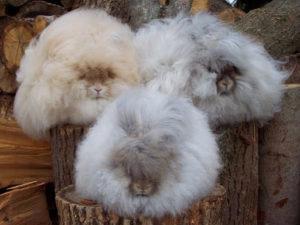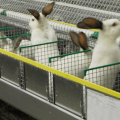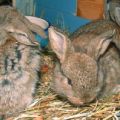How much does a rabbit weigh on average and a table of indicators by month, meat yield
Proper care and a good diet are not all parameters that you should pay attention to when breeding rabbits in your garden plot. It is important to keep track of how quickly the animal is gaining weight each month. This is an indicator of health. There are whole tables of exact norms of how much a rabbit normally weighs in a given period of time. You need to check with them in order to understand whether the individual is developing correctly.
Standard indicators
The weight of a live rabbit varies from 3.8 to 5.5 kg. There are rare exceptions to the rule. Farmers breed giant animals weighing up to 8-9 kg. The carcass of a killed rabbit is 25-30% smaller. Losses are the skin, the head, the entrails. Therefore, when we slaughter an individual of 5 kg, we get a carcass weighing no more than 3.5 kg.
Newborn rabbits weigh about 60 grams. For a month, they increase 10-12 times. All this time they feed exclusively on mother's milk. And by 5 months, the animal should already weigh at least 3 kg. The rabbits should gain about 60 grams per day.
Table of the average weight of different breeds by month
Weight in kilograms.
| Breed / age (indicated in months) | 1 | 3 | 5 | 7-8 |
| Flanders belgian | 0,7 | 2,6 | 4,6 | 6,9-7,1 |
| Giant white | 0,6 | 2,3 | 3,7 | 5-5,1 |
| Butterfly | 0,550 | 2,4 | 3,5 | 4,2 |
| Giant blue royal | 0,5 | 2 | 3,3 | 4,3 |
| German giant | 1,1 | 4,750 | 7,1 | 8,9 |
| New Zealand | 0,5 | 2,5 | 3,5 | 4,150 |
| California | 0,4 | 2,7 | 3,5 | 4,150 |
| Silver | 0,4 | 2,2 | 3,650 | 4,9 |
| Black-brown | 0,6 | 2,5 | 3,550 | 4,8 |
| Gray giant | 0,5 | 2,2 | 3,6 | 4,8 |
| French ram | 1 | 2,6 | 4,3 | 5,5 |
| Soviet marder | 0,5 | 2,1 | 3,2 | 4,2 |
| Soviet chinchilla | 0,6 | 2,8 | 3,5 | 4,8 |
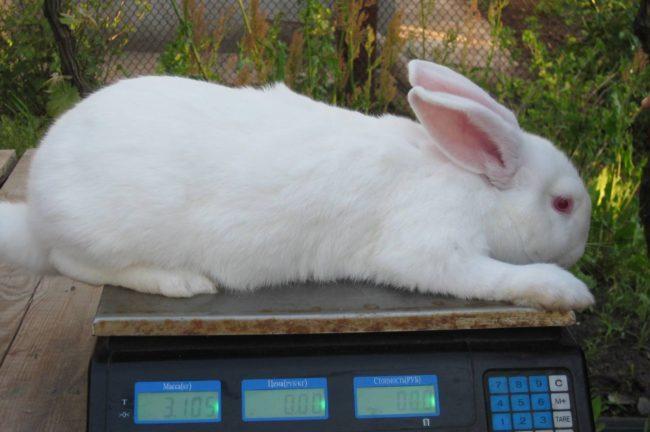
The weight of an adult animal corresponds to 8 months of age. Rabbits 7-8 months old are suitable for slaughter. Moreover, the meat yield will be 30-40% less than the live weight.
What affects weight gain?
There are several parameters that affect adequate weight gain in rabbits:
- Genetic predisposition.
- Proper nutrition. The diet should include various feeds, minerals, vitamins.
- Feeding is organized 2-3 times a day.
- Access to drinking water. She must always be present.
- Use of food additives. With their help, you can promote rapid weight gain, as well as the formation of good immunity.
- The physical condition of rabbits depends on the comfort level of their enclosures and proper care.

By choosing meat types of breeds, adhering to these rules, you can achieve excellent results in breeding rabbits.
How does the rabbit's milkiness affect growth?
Two months after birth, the rabbits feed exclusively on mother's milk. It contains all the necessary trace elements, nutrients, vitamins.They get immunity with milk.
And if it is produced in sufficient quantities, babies quickly gain their weight.
The female's lactation level depends on many factors:
- breed;
- season;
- age;
- what is the okrol;
- number of rabbits.
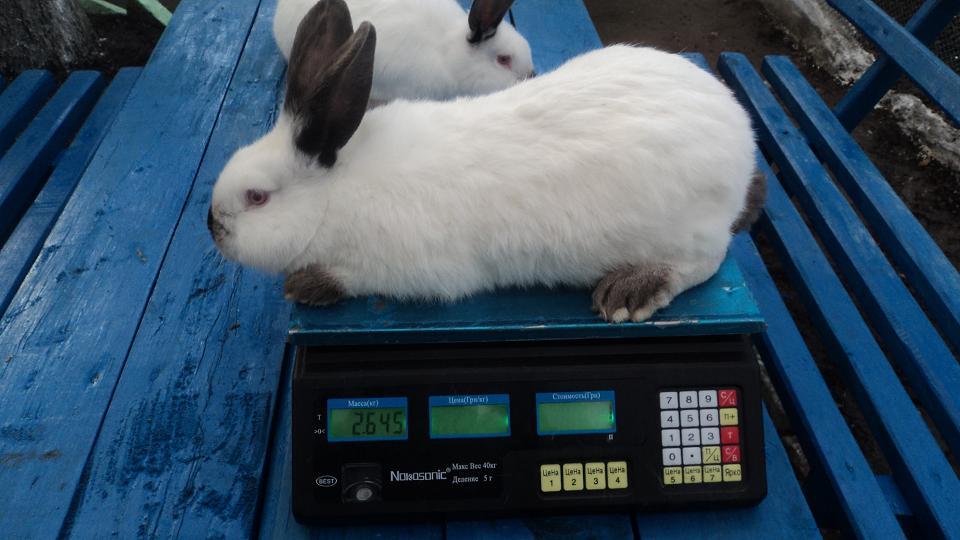
There are breeds that are distinguished by increased milkiness. The championship belongs to the females of the Californian breed.
In order for the rabbit to be able to fully feed the offspring, you need to adhere to the recommendations:
- During this period, it is advisable to leave compound feed as the main thing in the diet. It is important that it is intended specifically for lactating rabbits. It has everything to improve milk production and recovery after childbirth.
- Include protein foods on the menu. It is protein that is the building material of the body. There should not be a shortage of it. Therefore, you need to add clover, soy, alfalfa, peas to the diet.
- Add meat and bone meal. Be careful with this ingredient. This product changes the taste of milk. If you give a large amount of meat and bone meal, rabbits can permanently refuse breast milk.
- The fat content of milk is important for the active growth of rabbits. If at the beginning of lactation it is high, then it decreases over time. You can support milk fat content with foods such as grains, bran rich in fiber, as well as seeds of squash, pumpkin, sunflower, which contain fatty acids.
It is possible to determine that the rabbit has problems with feeding the offspring by the appearance of the rabbits. They will have shriveled tummies and a lifeless look. In this case, the farmer must take responsibility for himself and feed the babies on his own, separating them from the rabbit.
The best time for the appearance of rabbits is summer. Then you can provide the rabbit with the necessary food. And the offspring will grow and develop normally. And by the appointed time he will be able to gain sufficient body weight.

